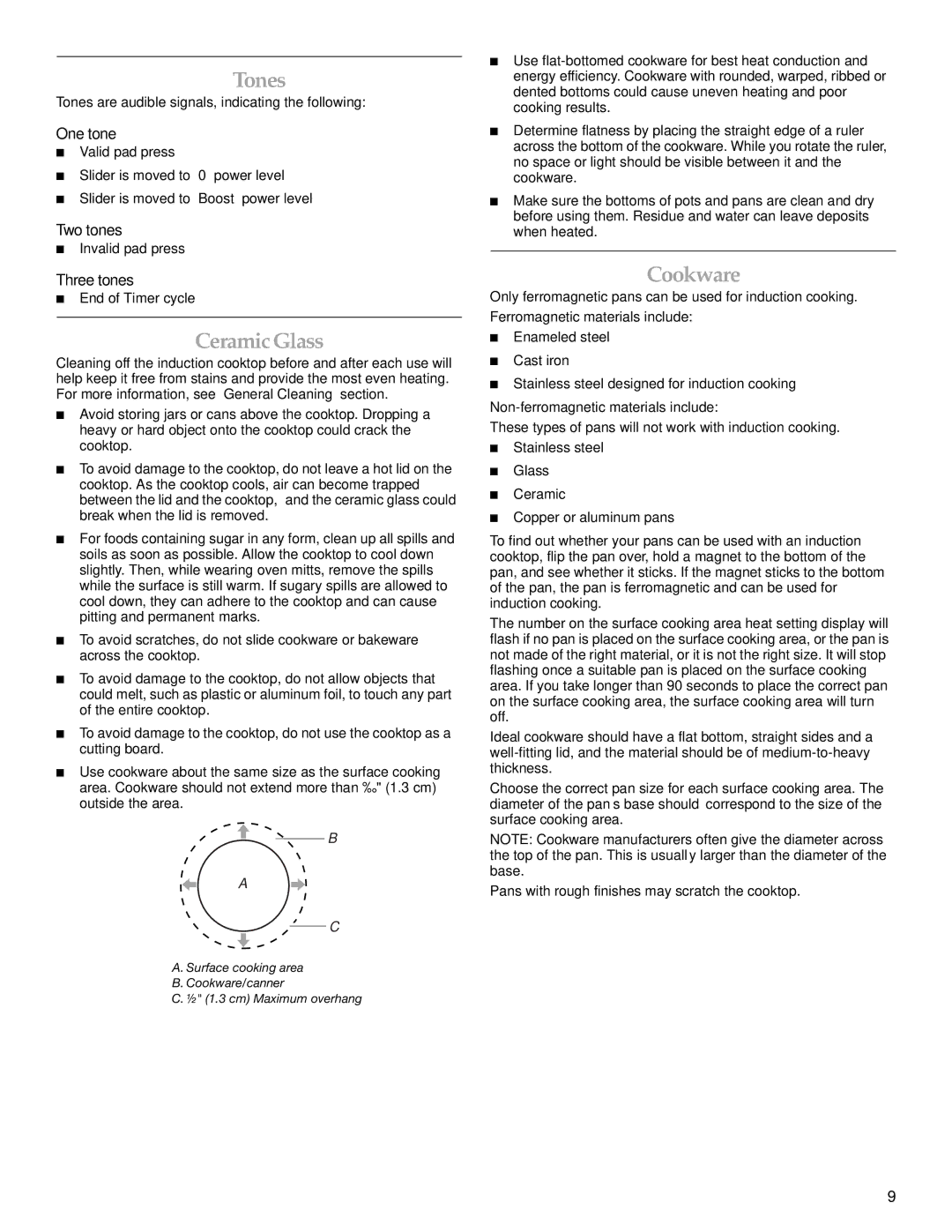
Tones
Tones are audible signals, indicating the following:
One tone
■Valid pad press
■Slider is moved to “0” power level
■Slider is moved to “Boost” power level
Two tones
■Invalid pad press
Three tones
■End of Timer cycle
CeramicGlass
Cleaning off the induction cooktop before and after each use will help keep it free from stains and provide the most even heating. For more information, see “General Cleaning” section.
■Avoid storing jars or cans above the cooktop. Dropping a heavy or hard object onto the cooktop could crack the cooktop.
■To avoid damage to the cooktop, do not leave a hot lid on the cooktop. As the cooktop cools, air can become trapped between the lid and the cooktop, and the ceramic glass could break when the lid is removed.
■For foods containing sugar in any form, clean up all spills and soils as soon as possible. Allow the cooktop to cool down slightly. Then, while wearing oven mitts, remove the spills while the surface is still warm. If sugary spills are allowed to cool down, they can adhere to the cooktop and can cause pitting and permanent marks.
■To avoid scratches, do not slide cookware or bakeware across the cooktop.
■To avoid damage to the cooktop, do not allow objects that could melt, such as plastic or aluminum foil, to touch any part of the entire cooktop.
■To avoid damage to the cooktop, do not use the cooktop as a cutting board.
■Use cookware about the same size as the surface cooking area. Cookware should not extend more than ½" (1.3 cm) outside the area.
B
A
C
A. Surface cooking area
B.Cookware/canner
C.½" (1.3 cm) Maximum overhang
■Use
■Determine flatness by placing the straight edge of a ruler across the bottom of the cookware. While you rotate the ruler, no space or light should be visible between it and the cookware.
■Make sure the bottoms of pots and pans are clean and dry before using them. Residue and water can leave deposits when heated.
Cookware
Only ferromagnetic pans can be used for induction cooking.
Ferromagnetic materials include:
■Enameled steel
■Cast iron
■Stainless steel designed for induction cooking
Non-ferromagnetic materials include:
These types of pans will not work with induction cooking.
■Stainless steel
■Glass
■Ceramic
■Copper or aluminum pans
To find out whether your pans can be used with an induction cooktop, flip the pan over, hold a magnet to the bottom of the pan, and see whether it sticks. If the magnet sticks to the bottom of the pan, the pan is ferromagnetic and can be used for induction cooking.
The number on the surface cooking area heat setting display will flash if no pan is placed on the surface cooking area, or the pan is not made of the right material, or it is not the right size. It will stop flashing once a suitable pan is placed on the surface cooking area. If you take longer than 90 seconds to place the correct pan on the surface cooking area, the surface cooking area will turn off.
Ideal cookware should have a flat bottom, straight sides and a
Choose the correct pan size for each surface cooking area. The diameter of the pan’s base should correspond to the size of the surface cooking area.
NOTE: Cookware manufacturers often give the diameter across the top of the pan. This is usually larger than the diameter of the base.
Pans with rough finishes may scratch the cooktop.
9
